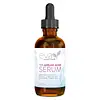What's inside
What's inside
 Key Ingredients
Key Ingredients

 Benefits
Benefits

 Concerns
Concerns

 Ingredients Side-by-side
Ingredients Side-by-side

Water
Skin ConditioningPolyglycerin-6
HumectantAzelaic Acid
BufferingNiacinamide
SmoothingPanthenol
Skin ConditioningSodium Hyaluronate
HumectantPotassium Sorbate
PreservativeAllantoin
Skin ConditioningGlycine
BufferingSodium PCA
HumectantSodium Lactate
BufferingArginine
MaskingProline
Skin ConditioningThreonine
PCA
HumectantAlanine
MaskingAspartic Acid
MaskingIsoleucine
Skin ConditioningSerine
MaskingValine
MaskingHistidine
HumectantPhenylalanine
MaskingHydroxyethylcellulose
Emulsion StabilisingSodium Benzoate
MaskingTetrasodium EDTA
Water, Polyglycerin-6, Azelaic Acid, Niacinamide, Panthenol, Sodium Hyaluronate, Potassium Sorbate, Allantoin, Glycine, Sodium PCA, Sodium Lactate, Arginine, Proline, Threonine, PCA, Alanine, Aspartic Acid, Isoleucine, Serine, Valine, Histidine, Phenylalanine, Hydroxyethylcellulose, Sodium Benzoate, Tetrasodium EDTA
Aloe Barbadensis Leaf Juice
Skin ConditioningAzelaic Acid
BufferingGlycerin
HumectantNiacinamide
SmoothingSorbitol
HumectantLecithin
EmollientTocopheryl Acetate
AntioxidantGlyceryl Linoleate
EmollientGlyceryl Linolenate
EmollientRetinyl Palmitate
Skin ConditioningSodium Ascorbyl Phosphate
AntioxidantXanthan Gum
EmulsifyingSodium Hyaluronate
HumectantPullulan
Leptospermum Scoparium Branch/Leaf Oil
TonicCentipeda Cunninghamii Extract
Skin ConditioningAscorbic Acid
AntioxidantDisodium EDTA
Gluconolactone
Skin ConditioningSodium Benzoate
MaskingPhenoxyethanol
PreservativeAloe Barbadensis Leaf Juice, Azelaic Acid, Glycerin, Niacinamide, Sorbitol, Lecithin, Tocopheryl Acetate, Glyceryl Linoleate, Glyceryl Linolenate, Retinyl Palmitate, Sodium Ascorbyl Phosphate, Xanthan Gum, Sodium Hyaluronate, Pullulan, Leptospermum Scoparium Branch/Leaf Oil, Centipeda Cunninghamii Extract, Ascorbic Acid, Disodium EDTA, Gluconolactone, Sodium Benzoate, Phenoxyethanol
 Reviews
Reviews

Ingredients Explained
These ingredients are found in both products.
Ingredients higher up in an ingredient list are typically present in a larger amount.
Azelaic acid is a multitasker ingredient that helps treat acne, pigmentation, and irritation. It is a great option for sensitive skin.
What makes azelaic special?
The best thing about azelaic acid is it's gentleness. It's generally well-tolerated and safe to use alongside other actives like niacinamide or salicylic acid.
Unlike AHAs, azelaic acid will not make you photosensitive/sun sensitive.
You can find this ingredient naturally occurring in grains like wheat, rye, and barley. In cosmetics, azelaic acid is typically lab-made, which is more stable and effective.
Learn more about Azelaic AcidNiacinamide is a multitasking form of vitamin B3 that strengthens the skin barrier, reduces pores and dark spots, regulates oil, and improves signs of aging.
And the best part? It's gentle and well-tolerated by most skin types, including sensitive and reactive skin.
You might have heard of "niacin flush", or the reddening of skin that causes itchiness. Niacinamide has not been found to cause this.
In very rare cases, some individuals may not be able to tolerate niacinamide at all or experience an allergic reaction to it.
If you are experiencing flaking, irritation, and dryness with this ingredient, be sure to double check all your products as this ingredient can be found in all categories of skincare.
When incorporating niacinamide into your routine, look out for concentration amounts. Typically, 5% niacinamide provides benefits such as fading dark spots. However, if you have sensitive skin, it is better to begin with a smaller concentration.
When you apply niacinamide to your skin, your body converts it into nicotinamide adenine dinucleotide (NAD). NAD is an essential coenzyme that is already found in your cells as "fuel" and powers countless biological processes.
In your skin, NAD helps repair cell damage, produce new healthy cells, support collagen production, strengthen the skin barrier, and fight environmental stressors (like UV and pollution).
Our natural NAD levels start to decline with age, leading to slower skin repair, visible aging, and a weaker skin barrier. By providing your skin niacinamide, you're recharging your skin's NAD levels. This leads to stronger, healthier, and younger looking skin.
Another name for vitamin B3 is nicotinamide. This vitamin is water-soluble and our bodies don't store it. We obtain Vitamin B3 from either food or skincare. Meat, fish, wheat, yeast, and leafy greens contain vitamin B3.
The type of niacinamide used in skincare is synthetically created.
Learn more about NiacinamideSodium Benzoate is a preservative. It's used in both cosmetic and food products to inhibit the growth of mold and bacteria. It is typically produced synthetically.
Both the US FDA and EU Health Committee have approved the use of sodium benzoate. In the US, levels of 0.1% (of the total product) are allowed.
Sodium benzoate works as a preservative by inhibiting the growth of bacteria inside of cells. It prevents the cell from fermenting a type of sugar using an enzyme called phosphofructokinase.
It is the salt of benzoic acid. Foods containing sodium benzoate include soda, salad dressings, condiments, fruit juices, wines, and snack foods.
Studies for using ascorbic acid and sodium benzoate in cosmetics are lacking, especially in skincare routines with multiple steps.
We always recommend speaking with a professional, such as a dermatologist, if you have any concerns.
Learn more about Sodium BenzoateSodium Hyaluronate is hyaluronic acid's salt form. It is commonly derived from the sodium salt of hyaluronic acid.
Like hyaluronic acid, it is great at holding water and acts as a humectant. This makes it a great skin hydrating ingredient.
Sodium Hyaluronate is naturally occurring in our bodies and is mostly found in eye fluid and joints.
These are some other common types of Hyaluronic Acid:
Learn more about Sodium Hyaluronate